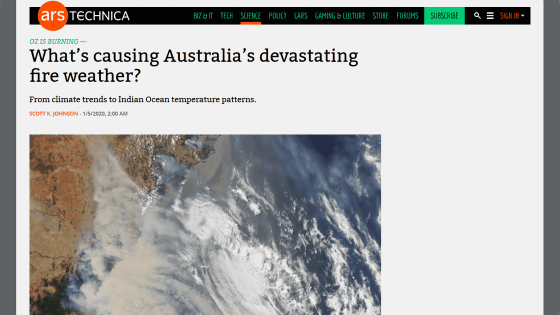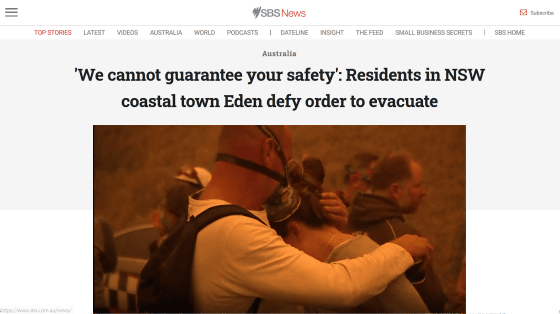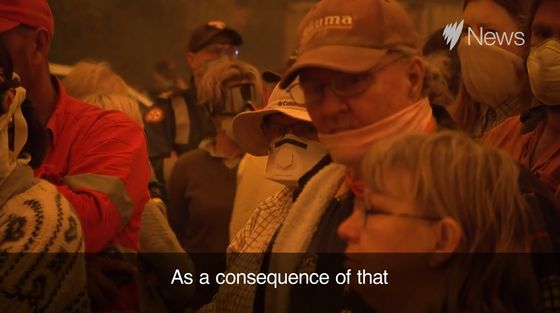A record of the devastating wildfires that have continued in Australia for months, why is it so devastating?

by
In Australia, large-scale forest fires have continued since around September 2019, mainly in the southeastern part, and as of January 5, 2020, the number of victims has risen to 23 and more than 1,500 buildings. The house is burned down . Various media reports on what the damage caused by wildfires is and why wildfires are so serious.
Australia's Devastating Wildfires Seen from Space | Live Science
https://www.livescience.com/australia-wildfires-seen-from-space-photos.html
Australia bushfires generate pyrocumulonimbus thunderstorm clouds --Insider
https://www.insider.com/australia-bushfires-generate-pyrocumulonimbus-thunderstorm-clouds-2019-12
What's causing Australia's devastating fire weather? | Ars Technica
https://arstechnica.com/science/2020/01/whats-causing-australias-devastating-fire-weather/

Since September 2019, Australia has been experiencing wildfires due to high temperatures and dryness, especially in the southeastern
Many people have already been forced to evacuate due to forest fires, and it was reported that thousands of people were evacuated to the beach on December 31st, which is a big day. New South Wales issued a week-long state of emergency on January 2. This is the third state of emergency due to a series of forest fires.
Australian broadcaster SBS News continues to report daily on forest fires that hit Australia.
'We cannot guarantee your safety': Residents in NSW coastal town Eden defy order to evacuate

In the town of Eden on the south coast of New South Wales, the color of the air seems to be reddish due to the fire. Residents wear masks and goggles to protect themselves from the air polluted by the fire.

Officials are calling on residents to evacuate ...

Residents with luggage are evacuating.

My last day of the decade felt like the apocalypse. Been covering the Australian bushfires for the last 6 weeks, but haven't seen anything like yesterdays fire that decimated the town of Conjola, NSW. #Bushfirecrisis #AustralianBushfires #NSWisburning work for @nytimes pic.twitter.com/KmVKqDMKsf
— Matthew abbott (@mattabbottphoto) January 1, 2020
In addition, a movie that captures the appearance of firefighters desperately fighting fires is posted on Twitter.
One of the scariest videos we've seen so far out of the Australia bushfires. #Australiafire #AustralianBushfire #AustraliaOnFire pic.twitter.com/aYxD9283ng
— Ralts (@ 200Ralts) January 5, 2020
The Princess Highway , the main national highway connecting Sydney and Port Augusta, seems to be on fire.
Fire on the Princes Hwy north of Moruya. NE winds are keeping the situation at bay at the moment. @SBSNews #nswfires pic.twitter.com/CrzbYqXaKz
— Cassandra Bain (@CassyBain) January 4, 2020
NASA 's satellite-based Earth Observing System (EOS) has also observed the effects of a catastrophic fire in southwestern Australia. According to NASA satellite data, forest fires in New South Wales have hit an area of 27,000 square kilometers by December 12, 2019.
Looking at the satellite image below taken on December 9, 2019, you can see that the smoke from the fire is widespread.

Forest fires
The heat waves and droughts that hit Australia are cited as the main contributors to the spread of forest fire damage in Australia. According to data released by the Bureau of Meteorology, 2019 was the hottest and driest year in Australia's observation history, making it a very fire-prone climate.
According to the Bureau of Meteorology ( @BOM_au ), 2019 was both the hottest and driest year ever measured in Australia.
— Robert Rohde (@RARohde) January 1, 2020
Under these conditions, it is not at all surprising that extreme wildfires have been running out of control. Pic.twitter.com/OI8ApduKcu
It has also been pointed out that 'Australia's large-scale forest fires have created unique weather.' A violent fire produces hot smoke and creates a local updraft, but sometimes the smoke of the fire creates clouds. That of cumulus clouds created by the convection of air to the smoke of the fire and the heat source fire cumulus clouds , but is referred to as, and growth in particular fire cumulus is large in Australia of forest fires, fire clouds reported to the Australian Bureau of Meteorology and has occurred Did.
Pyro-cumulonimbus clouds have developed to altitudes over 16km in East #Gippsland this afternoon. These fire-induced storms can spread fires through lightning, lofting of embers and generation of severe wind outflows #VicWeather #VicFires pic.twitter.com/gZN6sC7meU
— Bureau of Meteorology, Victoria (@BOM_Vic) December 30, 2019
This is a diagram in which the Bureau of Meteorology explained in an easy-to-understand manner the mechanism of fire cumulonimbus generation and the effects of fire cumulonimbus clouds. Fire cumulonimbus clouds grown by forest fires may rain to extinguish the fire, but strong winds may widen the range of fires and lightning may cause new fires.

Following the spread of forest fire damage, Australian Prime Minister Scott Morrison held a press conference on January 4. It has been revealed that it will mobilize 3,000 reserve soldiers for fire extinguishing activities by introducing more military vessels and helicopters for rescue and fire extinguishing activities of residents.
There are growing criticisms in Australia of accusing Prime Minister Morrison of 'going to Hawaii on Christmas holidays despite the growing wildfires.' 'I deeply regret having left my family and the country at this time, which offended many Australians who were affected by the tragic wildfires,' Morrison said. I am returning to Japan on December 22nd, ahead of schedule.
Related Posts:







